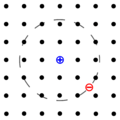Exciton facts for kids
An exciton is like a tiny, special pair made of an electron and an electron hole. Imagine an electron as a tiny particle with a negative electric charge. An electron hole is like a missing electron, which acts as if it has a positive electric charge.
When an electron and an electron hole are attracted to each other and stick together, they form an exciton. Because the electron is negative and the hole is positive, their charges cancel each other out, making the exciton electrically neutral (it has no overall charge). Excitons are also called "quasiparticles" because even though they are made of other particles, they act like a single particle themselves.
Contents
What is an Exciton?
Excitons are special because they can move through certain materials, like semiconductors, without carrying an electric current. Instead, they carry energy. Think of it like a tiny packet of energy moving around.
How Excitons Form
Excitons usually form when a material absorbs energy, often from light. When light hits a material, it can give energy to an electron. This extra energy can make the electron jump to a higher energy level, leaving behind an "electron hole" where it used to be. If the electron and the hole stay close enough and are attracted to each other, they form an exciton.
Where are Excitons Found?
Excitons are mostly found in materials called semiconductors and insulators. These are materials that don't conduct electricity as well as metals do. Scientists study excitons to understand how these materials behave and how they interact with light.
Why are Excitons Important?
Excitons play a big role in how materials interact with light. They are important for:
- LEDs (Light-Emitting Diodes): These are the lights you see in screens and many lamps. Excitons help them produce light.
- Solar Cells: These devices turn sunlight into electricity. Excitons help capture the energy from sunlight.
- Lasers: Excitons are involved in how some lasers work.
- New Technologies: Scientists are exploring how excitons could be used in future technologies, like very fast computers or new types of sensors.
Studying excitons helps us create better electronic devices and understand the tiny world of materials.
Images for kids
See also
 In Spanish: Excitón para niños
In Spanish: Excitón para niños


